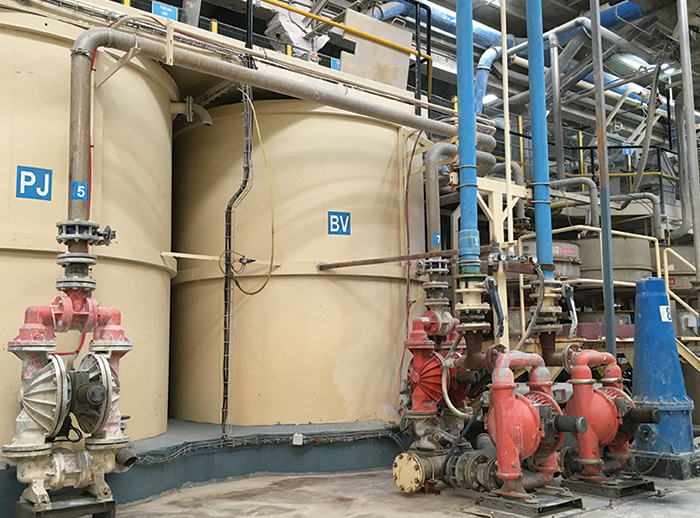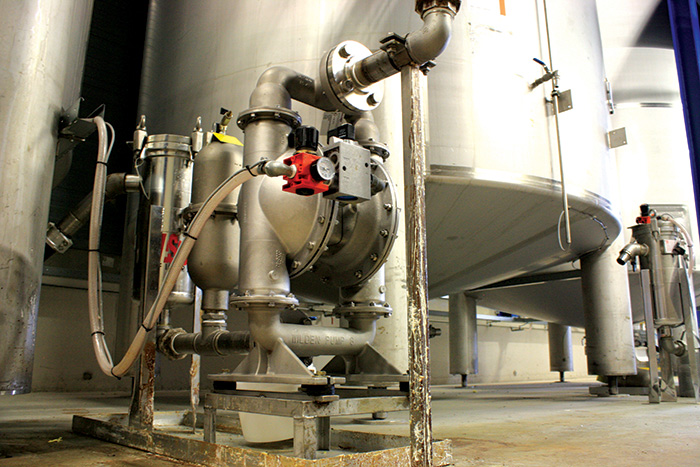Leveraging this expertise solves customer problems and creates a sustainable competitive advantage.
By Nate Maguire
In industrial business-to-business equipment markets, manufacturers are faced with an increasingly difficult operating environment. Energy price volatility, the increasing costs of regulatory compliance and public demands for improved environmental stewardship with regard to scarce resources are three prominent factors now impacting industrial organizations around the world.

Image 1. Air-operated double diaphragm (AODD) pumps in operation at a ceramic plant in Spain (Images courtesy of PSG)
In confronting these challenges, manufacturers must adapt in numerous ways, including investing in next-generation technologies.
Smart supervisory control and data acquisition (SCADA) systems can reduce downtime through proactive monitoring, and energy-efficient pump technology delivers operating cost savings, hedges against energy-price fluctuations and helps companies meet their environmental stewardship goals by reducing carbon emissions.
However, the adoption of any new technology can dramatically increase the complexity of business operations at a time when cost pressures and economic headwinds threaten to curtail growth and profitability. Further, these technology investments require knowledge and expertise to build, operate and maintain. Many industrial producers, like most businesses, face resource constraints and are operating with leaner staffing levels than ever before. As a result, they are finding they do not possess the in-house expertise to effectively select, build, operate and maintain increasingly complex equipment and systems, and often are forced to turn to third-party organizations with specialized expertise for support.
Pump manufacturers in particular, along with their related distributors, engineering firms, consultants and other third parties, are stepping up to supply this critical applications expertise to end-user customers. Properly deployed applications expertise can unlock value for industrial producers, and organizations that build superior expertise in their markets can gain a significant competitive advantage.
The Challenge
Industrial manufacturers are facing an increasingly difficult business environment, one that is often impacted by these and other critical factors:
- Energy-price volatility
- Regulatory compliance legislation and associated costs
- Public/customer expectations for enhanced resource stewardship
Energy-Price Volatility
Price volatility is defined in the energy industry as how quickly or widely electricity and/or natural gas prices change over a given time period.
Prices are governed by supply and demand, where demand is impacted by factors such as weather patterns, economic conditions and consumer behavior. In recent years, price volatility has increased in the energy market. To protect against this volatility, many companies “hedge,” or buy, a commodity at a price that is locked in over a set period of time.
While this may improve peace of mind for the operator, hedging is costly and doesn’t create value for the operator beyond reducing energy-cost volatility.
The severity and potential impact of price volatility is such that in its 2015 report titled, “The New Normal,” the World Energy Council (WEC) said, “The uncertain impact of volatile energy and commodity prices […] has now established itself as the number-one issue for energy leaders worldwide.”
The good news is that global energy leaders have recognized this challenge and are beginning to take measures to address it.
According to Francois Moisan in WEC’s triennial 2016 report, “Energy Efficiency: A straight path towards energy sustainability,” the increase in energy-efficiency legislation around the world “signifies a strengthening and consolidation of the industrial commitment to energy efficiency.”
The report does also indicate, however, that more “can and should be done to improve the efficiency of energy production and use.” This is noteworthy for industrial manufacturers because, as the WEC also points out, “industrial electric motors and electric motor-driven systems consume almost half of the total electricity and account for 70 percent of the total (amount of) electricity consumed in industry.”
For many industrial companies where energy represents a significant portion of operating costs, price volatility will continue to be a challenge. These companies will be self-served to evaluate energy-saving technology, but will only reap the greatest rewards if they do so by taking into account the intricacies of equipment in the specific applications in which they operate.
Only by developing and using the proper applications expertise will they be able to identify and choose the technology that is best suited to mitigate the cost risks associated with energy volatility.

Image 2. A stainless steel AODD pump in a glue and adhesive manufacturing facility in the Netherlands
Regulatory Compliance
Regulatory compliance is by definition a necessity for businesses in the modern world. These laws collectively shape the environment in which businesses operate. The number of federal regulations in the U.S. has been growing steadily for several decades, requiring more and more investments by many businesses in order to maintain compliance. In fact, a study by George Mason University shows that “the effects of federal regulation on value added to the (U.S.) GDP for a panel of 22 industries…over a period of 35 years…dampened (GDP by approximately) 0.8 percent per year since 1980, eliminating $4 trillion in growth by 2012.”
Two prominent examples in the industrial-manufacturing universe are the motor-efficiency regulations that have been developed by the U.S. Department of Energy (DOE) and the International Electrotechnical Commission (IEC) in Europe.
The bottom line is that regulations are an unavoidable requirement for doing business in almost any jurisdiction in the world.
Many advances in technology have been geared toward meeting the demands of a stricter regulatory environment (See Sidebar: Motoring Ahead), but will be optimized only if they are applied with the appropriate applications expertise. For example, the misapplication of a pump (for example, incorrectly sizing the pump for its application) will likely lead to far greater energy consumption than can be saved from improvements in motor technology.
Expectations for Resource Stewardship
A phrase that has gained stature over the past two decades in all forms of business is “corporate social responsibility,” or CSR, which is commonly characterized as “business practices involving initiatives that benefit society.”

Image 3. An eccentric disc pump moving carbonated-beverages at a bottling plant in Hungary
An article in the June 18, 2016, issue of the International Journal of Business and Management titled, “Corporate Social Responsibility and Consumer Buying Behavior in Emerging Markets,” stated that “consumers now want companies to behave ethically in addition to providing quality product[s]...”
The obvious implication is that those companies that are perceived to be inattentive or irresponsible stewards regarding shared resources (for example, community water supplies or air quality) risk a political and social backlash that could impact the company’s standing and ability to do business in the communities in which it operates.
Therefore, it should not be surprising that a report from Harvard Business School titled, “The Impact of Corporate Social Responsibility on Investment Recommendations,” revealed that “recent research shows spending money on corporate social responsibility is no longer seen as a detriment to a company’s profitability. Stock analysts now view such expenditures as essential to a company’s long-term brand and value.”
To improve CSR standing, more and more companies are investing additional time and resources toward incorporating new technologies, changing operating practices and even adjusting business strategies to assuage the corporate-responsibility demands of the buying public.
Indeed, these resources can only be optimized by developing and applying expert knowledge of the business, its systems and the local environment in which it operates. Businesses that develop and use this knowledge will help satisfy the needs of the publicwhile achieving positive outcomes in resource stewardship.
In summary, today’s industrial-equipment providers face an increasingly difficult operating environment, which includes energy price volatility, the increasing costs of regulatory compliance, and public demands for improved environmental stewardship.
To address these market dynamics and achieve positive business outcomes, many companies are purposefully developing and leveraging applications expertise, especially when selecting critical pumping technologies and systems.
Part 2 of this article, which will appear in the August 2017 issue of Pumps & Systems (read it here), will identify some of the best ways that applications knowledge can be gained and then implemented to develop the best pumping systems for unique—and critical—industrial-manufacturing applications.
ABOUT THE AUTHOR
Nate Maguire is senior director of business development for Dover and PSG. He can be reached at 909-222-1309 or nate.maguire@psgdover.com. Headquartered in Oakbrook Terrace, Ill., PSG is comprised of several pump brands. For more information on PSG, please visit psgdover.com.